5 Techniques To Drastically Improve Email Open Rates, Click-Through Rates and More
If you’re not directing a significant part of your marketing efforts towards email marketing, then you’re missing out on a lot of business.
According to Gartner research director Noah Elkin, in a report available to Gartner clients, a recent survey of digital marketers found that “79 percent of respondents indicated that they use email marketing to support their digital commerce efforts. Moreover, they attribute 12 percent of their total digital commerce revenue to email.”
Email marketing will drive an estimated $500 billion in digital commerce revenue in 2018 (a nearly 80 percent increase over 2016).
In order to get a piece of that pie, your small to midsize business (SMB) needs to improve its email open rates and capture more leads via your email marketing campaigns.
We surveyed almost 200 consumers in order to find out what types of marketing emails they respond to best. Here, we give you five top tips on how to improve your email marketing game and get more eyes on your content.
Here’s our five tips, so you can jump to any of them:
1. Clearly State What Emails Will Contain
3. Highlight Offers and Discounts
4. Craft A Dynamic Opening & Clear Outline
5. Use Plenty of Pictures (But Not Only Pictures)
1. Clearly State What Emails Will Contain
The first key question we posed in our consumer survey asked our respondents how often they open unsolicited emails from businesses (which, whether they’ve signed onto your mailing list knowingly or not, is how most consumers view your email campaigns), in order to get a sense of how they respond to marketing emails in general. Here’s what we found:
How often do you open unsolicited emails from businesses?
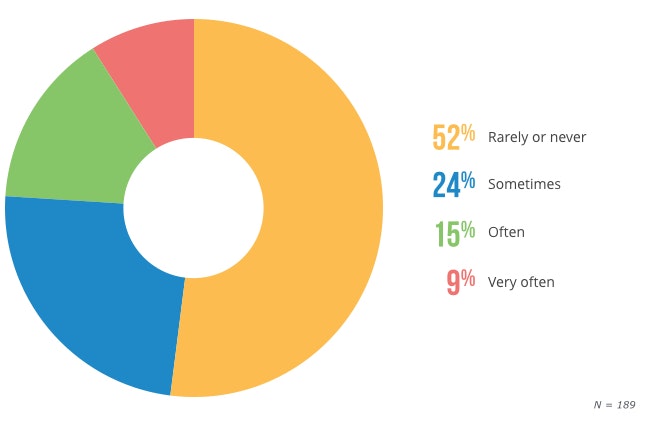
With more than half of respondents indicating that they “rarely or never” open marketing emails, and another quarter that they only “sometimes” open them, you are left with less than a quarter of consumers who open your emails either “often” or “very often.”
This means that you need to figure out what causes those consumers to open emails, so that yours will get read. To help determine this, we next asked our respondents what factor plays the most significant role in their decision to open an unprompted marketing email. Our results were as follows:
Which of the following plays the most significant role in whether you open an unprompted marketing email or not?

Almost 60 percent of respondents indicated that interest in the product or service advertised is what prompts their decision whether or not to open a marketing email, a fairly wide majority.
By contrast, slightly over 20 percent indicated that their decision is based on the frequency with which they receive emails from that business, less than 15 percent that it is based on brand loyalty and only slightly more than five percent that it is based on the time of day that they receive the email.
The main thing you can do to make consumers more likely to open your emails is crafting a subject line that clearly announces the product/service you’re advertising.
Fortunately, the majority of the rest of our survey focused on asking respondents how they respond to specific aspects of subject lines. For instance, here’s what we found when we asked how effective our respondents find email subject lines with a clear statement of content:
How effective is the following type of subject line at influencing you to open an email: A subject line that clearly states what will be in the email?
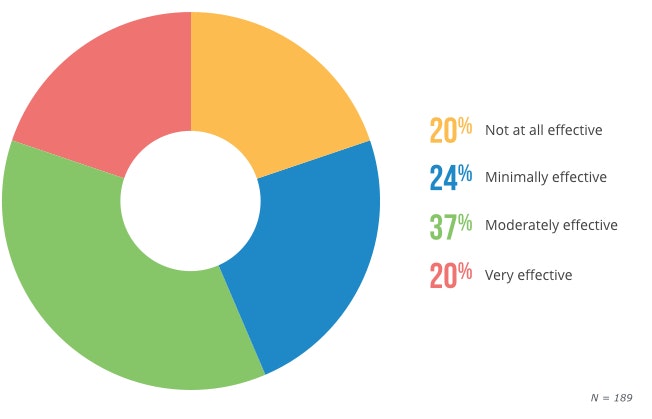
Out of all the types of subject lines about which we asked, this type received the highest percentage of “very effective” responses, 20 percent, as well as another third of respondents indicating these subject lines are “moderately effective.”
For more than half of your customers, then, a clear subject line that directly states the content of your email will be most likely to get them to open that mail.
Recommended Action: Don’t overwhelm your customers with too many emails; keep them to once a week, at most. Those emails should clearly state in their subject line what the actual content of that email will be.
2. Abandon Fake Urgency
If clear subject lines are most likely to get consumers to open an email, then what’s least likely? Of all the types of subject lines we asked about, the most ineffective proved to be those subject lines that create a sense of urgency.
How effective is the following type of subject line at influencing you to open an email: A subject line that creates a sense of urgency?

Well over half of our respondents find a sense of urgency to be a turn-off, and list it as “not at all effective,” with another 22 percent finding it “minimally effective.”
These results might be indicative of consumers tiring of “scare tactics” to get them to open an email. They’re increasingly able to read through the urgency you’re trying to create and understand that your hyperbole is masking a lack of content.
To that end, think of your email subjects in the same way that you do the headline or title tag for a piece of content. While urgent, dramatic, clickbait-y titles may have been popular a few years ago (“7 Facebook Hacks That Will Literally Save Your Life!”), in today’s atmosphere of “fake news” readers want a title that doesn’t attempt to obfuscate an article’s purpose.
The same is true of email subjects. A false sense of urgency is more likely to scare your customers off than it is to scare them into opening your emails.
Recommended Action: Stop writing email subjects that employ obvious scare tactics and other manipulations to create a false sense of urgency. Use the subject line to highlight the email’s content truthfully, and customers who are interested in that content will be more likely to read on.
3. Highlight Offers and Discounts
In line with our respondents’ preference for directness and clarity, another type of subject line that they noted to be relatively effective is one that alerts them to an offer or a discount:
How effective is the following type of subject line at influencing you to open an email: A subject line that presents an offer or discount?
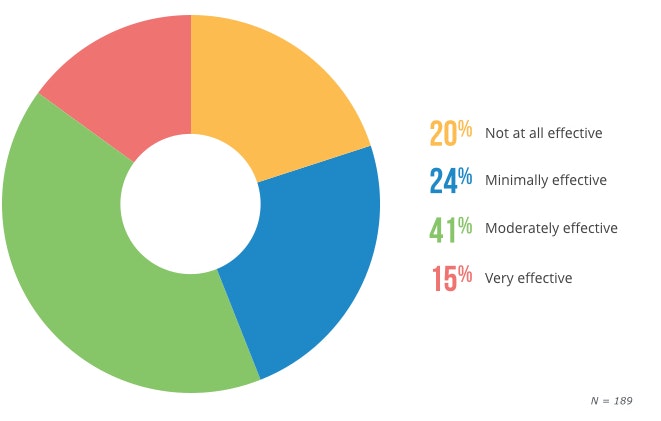
Over half of our respondents find offers and discounts in subject line either “very” or “moderately” effective. While this method isn’t quite as effective, overall, as a clearly stated subject line (though note that the two needn’t be mutually exclusive), it is still a strong tactic to boost your email open rates.
More importantly, providing a specific sales offer is the best way to get customers who do open your emails to actually click through to your website. This is no easy task, as our survey reveals:
How often do you click through to a business’ website from a marketing email they’ve sent you?

Given that over half of our respondents indicated that they “rarely or never” click through to a website, and another 40 percent only do so “sometimes,” it seems that only one out of 10 customers who open your email will then actually click through to your site. However, the most effective way to get them to do so is through a sales offer or discount:
What’s the primary reason you click through to a business’ website from an unprompted marketing email?

Only two of the answers to this question were chosen by more than one-tenth of our respondents—“I like the product/service advertised in the email” and “a specific sales offer.” Though you can certainly use your emails to try and make your product more attractive to potential customers, that seems to be a much larger brand management or reputation management project for your marketing team.
On the other hand, it is much easier, and twice as effective, to provide specific sales offers within your marketing emails that will attract readers to your website.
For instance, you can offer a coupon that they can only print out from your site, or provide them with a discount code that they can use when making a purchase online.
Recommended Action: Provide a specific offer to your customers in your marketing emails that they can only receive by clicking through to your website. This should improve your click-through rate and make customers more likely to open your future emails.
4. Craft A Dynamic Opening & Clear Outline
Once your customers actually open your email, how much of it do they actually read? According to our survey, not very much at all:
When you open an unsolicited email from a business, how far do you typically read?
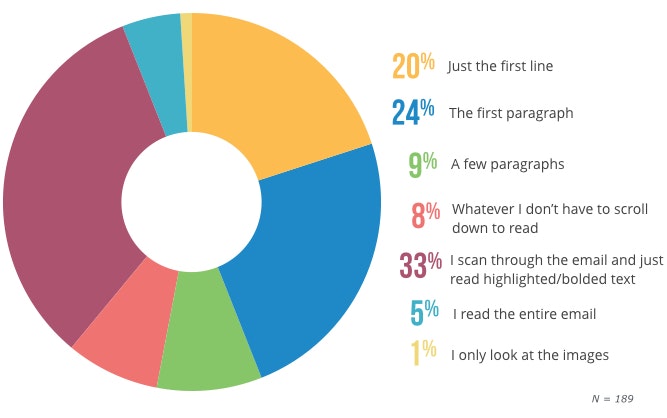
Only a tiny sliver of our respondents, five percent, indicated that they read the entire email. Far more common, our results show, is that respondents will only scan through the email (33 percent), or read the first paragraph (24 percent) or line (20 percent).
These results have two important implications for your own email marketing campaigns:
Your first paragraph, and especially your first sentence, must grab your customers’ attention if you want them to read further, click through to your site and/or open future emails
Your emails should feature a clear, easy-to-scan structure that creates an outline for readers who scroll through it quickly.
Though of course you will want to provide strong content throughout the entire body of your email, you need to be realistic about where your readers will focus, and spend the majority of your time perfecting those parts of your emails.
Recommended Action: Spend a good amount of time perfecting the first paragraph of all marketing emails, particularly the first sentence, and make sure that the rest of the email has a clearly outlined structure that is easy to scan.
5. Use Plenty of Pictures (But Not Only Pictures)
Finally, we wanted to know whether the consumers in our survey prefer emails with pictures or those with only text. Here’s what they said:
Do you prefer pictures in a marketing email or just plain text?
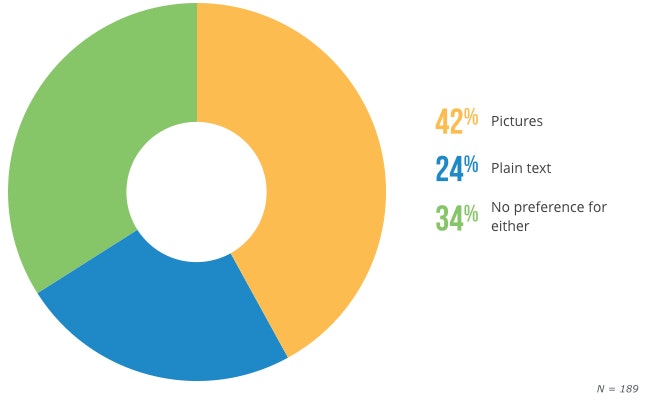
Though a third of our respondents didn’t have a preference one way or the other, almost twice as many preferred emails with pictures (42 percent) over those with plain text (24 percent).
However, despite the old adage about how many words a picture is worth, remember that those words are important, too. As shown in the result to our question about how far consumers read in a marketing email, only one percent of respondents indicated that they “only look at the images.”
This means that though images may draw your readers’ eye, and help create a more scannable piece, you shouldn’t abandon quality, content-rich text as your primary mode of communication.
Recommended Action: Never let an email go out without at least some sort of attractive image as part of it, but also don’t let those pictures speak for themselves. Create quality content to accompany the attractive images.
Next Steps
These five tips should get you started on creating marketing campaigns that will have a higher email open rate and click-through rate while simultaneously building brand awareness and loyalty amongst your customers.
How will you know whether these changes have made a difference, though?
We recommend using email tracking software, which can provide you with a set of tools that will allow you to track the emails you send out and collect analytical information about them (such as email open rates, the number of clicks on links and the number of downloads of attachments).
In doing so, you will be able to track just how much your email open rate and click-through rate have improved thanks to implementing these five improvements.